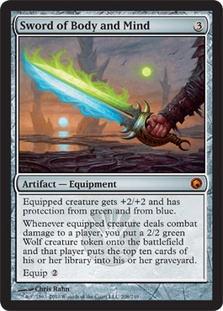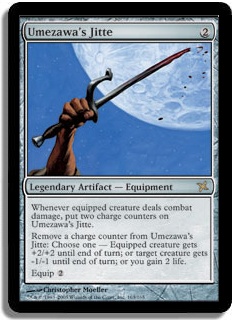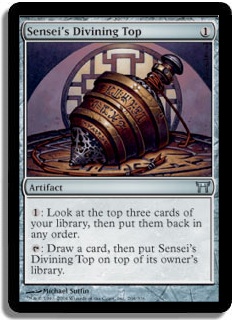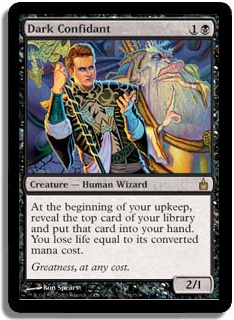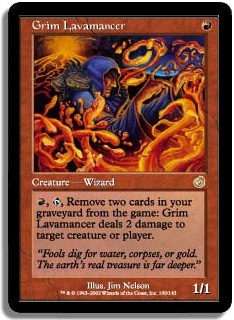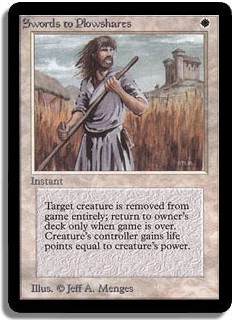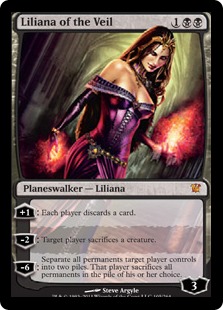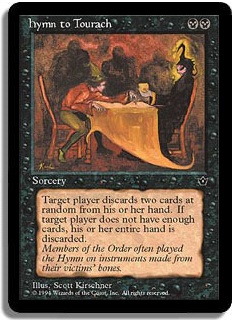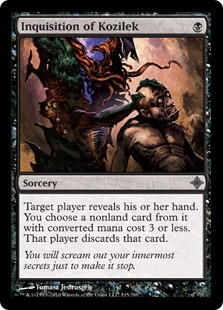Where do I begin… It’s been pretty much well over a year since I wrote an article. You see, last year around this time I was off traveling around the country with the Truth Tour. Magic was left behind for just about four months, and to my surprise, I didn’t really miss it. Every now and then I would check the coverage to see who was doing what, but I didn’t look into any articles or follow the current metagame of any formats.
Before I left for the Truth Tour, the format that interested me the most was Legacy. Standard had become somewhat comparable to playing cartoon bingo with SpongeBob SquarePants and pinochle with Rocko’s Modern Life (I’m not really sure what this means, but overall Standard isn’t the most skillful format).
You see, I remember the days where you had to innovate to succeed in Standard rather than just jam a bunch of mythic rares into a deck and call it "Mythic."
One of the decks that comes to mind is two-time Grand Prix Champion Jon Sonne’s Snake Tongue deck:
4 Flametongue Kavu
4 Mystic Snake
4 Aether Burst
4 Call of the Herd
4 Counterspell
2 Disrupt
4 Fact or Fiction
4 Fire / Ice
2 Syncopate
4 Urza’s Rage
8 Island
1 Karplusan Forest
3 Mountain
4 Shivan Oasis
4 Shivan Reef
4 Yavimaya Coast
SIDEBOARD:
3 Blurred Mongoose
3 Dodecapod
3 Gainsay
3 Hibernation
3 Hull Breach
Now this may seem like an obvious deck to build using come-into-play creatures and Aether Burst along with the interaction of Fact or Fiction and Call of the Herd, but back in 2002 there wasn’t coverage like there is today. Players had to brew more, either by themselves or with their small test group. With Legacy, however, even though there are SCG Open Series nearly every week and the top decks tend to put up high results, there is still a fair amount of brewing and metagame calling due to the large amount of cards that can be played.
As many people may know, I am a huge and possibly the only supporter—besides Patrick Sullivan—of Team Italia. In this article I am going to talk about the changes I have made to the deck. You see, the deck evolved quite a bit over the past year due to metagame shifts and my having a lot more practice with the deck. Figuring out exactly what the deck wants to do led me to make some changes to my original list.
The metagame went from being saturated with slower, controlling decks with Jace and combo decks such as Storm to being largely made up of fast, aggressive decks like RUG and combo decks like Reanimator and Elves.
First I will post the original list, and then underneath it I will post the current list and explain my card choices.
Original List
Creatures (16)
Lands (23)
Spells (21)

Updated List
Creatures (15)
Planeswalkers (3)
Lands (23)
Spells (19)

Below are my card choices.
Artifacts
1 Sword of Body and Mind: The newest addition to the deck. It started as Sword of Fire and Ice, which got replaced by Batterskull. Both were good, but with RUG being so popular along with Maverick and Elves, having protection from green is very important. Now, you might think it’s crazy to play a card that dumps ten cards into an opponent’s yard with Reanimator and Dredge running around, but it really isn’t that bad for a few reasons.
For starters, against those decks you don’t have to use the Sword. Against other decks, milling ten cards could be very important and getting another creature in attrition-based matchups is very important. Sometimes you will destroy your opponent’s board and exhaust their hand and then be left with only a Lavamancer or Stoneforge. After one attack with, say, just a Jitte, your opponent can just draw a Plow or a removal spell of some sort and you will be left with just a Jitte and some counters. But with Sword of Body and Mind, you will get a replacement creature.
1 Umezawa’s Jitte: Probably the best equipment ever printed, and even though it doesn’t give you another creature, it can control the board and just destroy some decks. Recently Elf combo has been on the rise, and Jitte is one of your best weapons against them. Also, RUG has a hard time dealing with a Jitte since once it gets online their burn spells don’t do enough damage to kill your creatures. The equipment in general is important because most of your guys are not that big in terms of power (besides Hero), so they will get a boost to help end the game quickly once you have gained the advantage.
2 Sensei’s Divining Top: The only other artifacts in the maindeck. Originally the deck only had one, but the Top has proven itself to be very important since it works as a tool to help manipulate your draws. Late game you don’t want to draw your discard spells, so you are able to Top to the card you want, then with Stoneforge and sac lands you can shuffle away the cards you don’t want; it works like a mini Brainstorm that sticks around. It is also nice with Dark Confident so you are able to avoid hitting a three or four to preserve your life total. Overall, I am very happy with two Tops.
Creatures
4 Dark Confidant: I think he is the most important creature in the deck. If he goes unanswered, the game can end quickly due to the card advantage you gain from him. One of the best starts you can get is turn 1 discard spell to remove their way to stop Dark Confidant, then turn 2 Dark Confidant to start drawing extra cards. It is also fine to hold Dark Confidant until it is your last creature to play in certain matchups to draw out all of their removal so Dark Confidant will stick.
4 Grim Lavamancer: Moving from the most important creature in the deck to the least, Lavamancer can’t close out a game quickly and is just a 1/1. However, it does play an important role in the deck.
Lavamancer can control the board and be a nightmare against decks like Maverick and Elves. With the ability to fill up your graveyard quickly with cheap spells and sac lands, he will almost never run out of fuel. Even against a deck like RUG, Lavamancer is important as they will be forced to kill it if they want to play out a Delver, which will open up the way for a Dark Confidant to come down. It can also keep Tarmogoyf in check by removing card types in your graveyard that your opponent doesn’t have. Yes, it is weak against the combo decks, but you will just side them out after board in favor of more powerful cards against combo such as Pyroblast and Surgical extraction.
3 Hero of Bladehold: Most people will probably be surprised by this since Hero doesn’t even really see that much play in Standard anymore. However, he is super good in this deck since he can end the game in just two attacks, which was something this deck was looking to have for a while. The problem with discard decks in general is sometimes you exhaust your opponent’s hand but can’t close it out in time before they draw out of it. Hero helps to stop this from happening. It is also great that he has four toughness, which means he avoids getting Lighting Bolted and can block Nimble Mongoose. Originally this slot was dedicated to Elspeth, but I believe Hero is much better.
4 Stoneforge Mystic: In the past few months I was feeling that this card lost a lot of value and I dropped it down to only three, but the way the metagame is recently shaping up having four seems good again. It is just a super consistent card that will gain you card advantage and bring another threat on to the board. In some matchups I tend to side out Stoneforge since they will most likely bring in artifact removal. RUG is a prime example of this, as Jitte and Sword are great against them so they bring in Ancient Grudge. Since you have a lot of cards against them, you can take out the Stoneforge package and blank some of their artifact removal.
Instants
4 Swords to Plowshares: Swords in my opinion is the best spot removal spell available. Some people are getting behind Path to Exile since RUG plays zero basic land. In addition, Plowing a Griselbrand is somewhat counteractive.
However, against the rest of the field I would much rather give my opponent a few life points instead of a land, especially since the whole point of the deck is to deny your opponent resources. In some games you will find yourself Plowing your own creature to either win a damage race or Plowing your Dark Confidant once he’s done his job to avoid taking too much damage and losing.
Planeswalkers
3 Liliana of the Veil: This is probably my favorite addition to the deck because she serves as a multitasker. She is an awesome removal spell since she can take out hexproof creatures or a fatty that just came into play from the graveyard. She also serves as another discard spell and can pretty much win a game on her own with her ultimate ability. I will say that over 90% of the time you’ll want to tick her up, even if your hand is good.
I notice some players just let her sit there with a couple of counters because they think their hand is "too good." This is the wrong way to look at it, and your goal should just be to reach her ultimate if there are no creatures you need to get rid of.
 Sorceries
3 Hymn to Tourach
2 Inquisition of Kozilek
3 Vindicate
3 Thoughtseize
The sorceries in the deck consist of eight cheap discard spells plus a catchall in Vindicate. I went with a 3/2 split on Inquisition and Thoughtseize initially because even though the life loss hurts, the Inquisitions miss on some very important spells. Some people might say, "Oh yeah, you can’t get a Force of Will," but truth be told Force of Will is something you almost welcome anyway since they two for one themselves in the process. In addition, you don’t really have a specific spell you want to force through. The cards you want to take most are Jace and Sneak Attack. Another thing you can hit with a Thoughtseize is Emrakul since a scenario that can come up is them trying to hide their good cards with a Brainstorm, which will be shuffled away once you discard the 15/15 Eldrazi.
Hymn to Tourach is such a great card, but after playing a bunch I began to realize that maybe four copies were too many. Also, the two-drop slot is already filled with Stoneforge Mystic and Dark Confidant. In some matchups on the draw, don’t be afraid to board out your Hymns. I almost will always keep them in on the play except when I’m playing against Reanimator or Dredge.
Vindicate plays a very important role for the deck as you can answer almost anything with it. You just have to understand the matchup you are playing against and know what you want to use it on. Against U/W Stoneforge, Jace, the Mind Sculptor is their best weapon against you. Against Maverick, it’s Knight of the Reliquary. But in other matchups, you just want to deny them of their mana by using Vindicate as a Stone Rain. It just all depends on the matchup.
Lands
1 Plains
1 Swamp
4 Badlands
4 Bloodstained Mire
4 Marsh Flats
1 Plateau
4 Scrubland[/author]“][author name="Scrubland"]Scrubland[/author]
4 Wasteland
The land breakdown is straightforward: two basic lands to help get around Wasteland, Blood Moon, Price of Progress, and Back to Basics. You have eight fetch lands to help with your mana, Top, and Lavamancer. You have your duals, and, finally, the four Wasteland to continue the theme of denying your opponent resources.
When I was growing up, they would say you could play or draw; either way you have a full grip. But what I’m saying is this: when you’re facing a loaded Hymn and Wastelands, what’s the difference?
Lots of players don’t really know how to play with five cards and two lands. Sure, even the least experienced players can beat you with four lands and Jace, so you have to remember to try not let the game get to that state. Use your discard spells and Wastelands wisely. Lots of times it’s better to cut off their resources rather than to build your own because once they have nothing, a Stoneforge Mystic or Dark Confidant will push you way over the top.
The sideboard is solid, and it’s really situational on how to sideboard. There are some obvious swaps such as taking out Plow against the noncreature combo decks and bringing in Pyroblast against the blue-based decks. The more complex decisions are left up to you. Figure out how you want the game to play out in your head after board; then decide what cards are important.
In conclusion, I suggest you play this deck if you want to try something different, if you want to avoid the hate of Pyroblast and Submerge out of RUG sideboards, if you want to have Perish (which is one of the best cards against the recently popular Elves deck), if you want to have game against pretty much every deck, or if you just want to dust off your Badlands and play some Magic.
Thanks for reading,
Gerard Fabiano

